bombs
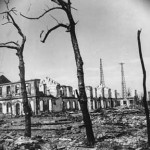 Anytime humans go to war, the one sure outcome is loss of life. That is just a fact of war. Of all the wars that the United States has been involved in, World War II interests me the most, because of my dad’s involvement, I’m sure. War is a brutal activity, but with the evil in the world, it is sometimes necessary. Evil nations leave us no choice but to step in. Such was that case with World War II, and Japan. On this day, March 9, 1945, the United States warplanes launched a new offensive against Japan. The campaign carried out involved dropping 2,000 tons of incendiary bombs on Tokyo over a two day period. Almost 16 square miles in and around the city were incinerated, and between 80,000 and 130,000 Japanese civilians were killed in the worst firestorm in recorded history.
Anytime humans go to war, the one sure outcome is loss of life. That is just a fact of war. Of all the wars that the United States has been involved in, World War II interests me the most, because of my dad’s involvement, I’m sure. War is a brutal activity, but with the evil in the world, it is sometimes necessary. Evil nations leave us no choice but to step in. Such was that case with World War II, and Japan. On this day, March 9, 1945, the United States warplanes launched a new offensive against Japan. The campaign carried out involved dropping 2,000 tons of incendiary bombs on Tokyo over a two day period. Almost 16 square miles in and around the city were incinerated, and between 80,000 and 130,000 Japanese civilians were killed in the worst firestorm in recorded history.
Early that morning, Air Force crews met on the Mariana Islands of Tinian and Saipan for a briefing. This would be a low level bombing attack on Tokyo beginning in the evening, but this one would be different. The planes would be stripped of all guns except for the tail turret. This would decrease the weight…increasing the speed of 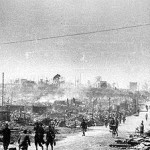 each Superfortress bomber. This also increased the bomb load capacity by 65 percent. Now each plane could carry more than seven tons of bombs. The most crucial thing, however, would be speed. If the plane didn’t make it out of the city, the airmen were warned to get to the water as fast as they could, because their very lives depended on it. Staying in the city would mean a fiery death, because they were going to be delivering the biggest firecracker the Japanese have ever seen.
each Superfortress bomber. This also increased the bomb load capacity by 65 percent. Now each plane could carry more than seven tons of bombs. The most crucial thing, however, would be speed. If the plane didn’t make it out of the city, the airmen were warned to get to the water as fast as they could, because their very lives depended on it. Staying in the city would mean a fiery death, because they were going to be delivering the biggest firecracker the Japanese have ever seen.
The first location would be the suburb of Shitamachi, which was composed of roughly 750,000 people. The destruction of Shitamachi would destroy the light industries, called “shadow factories,” that produced prefabricated war materials for Japanese aircraft factories. The citizens of Shitamachi never had a chance against the Superfortress B-29 bombers. Their fire brigades were undermanned, poorly trained, and ill equipped. All the people could do was to run from the inferno that the city had become. The planes…334 in all, came in a just 500 feet above the ground. Most of them didn’t make it. Doctors said, “The human carnage 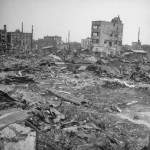 was so great that the blood-red mists and stench of burning flesh that wafted up sickened the bomber pilots, forcing them to grab oxygen masks to keep from vomiting.”
was so great that the blood-red mists and stench of burning flesh that wafted up sickened the bomber pilots, forcing them to grab oxygen masks to keep from vomiting.”
The entire raid lasted just a little longer than three hours. When it was over the Sumida River was clogged with bodies of the dead, burned beyond recognition. The sight was beyond anything anyone could have imagined. The loss of American lives was a mere 243 airmen, and these were considered to be acceptable losses. I suppose that these days, such a raid on known civilian targets would be considered unacceptable, but at the time it was considered acceptable, and even necessary. And it was successful, in a horrible sort of way.
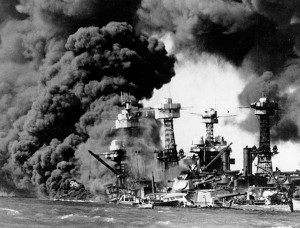
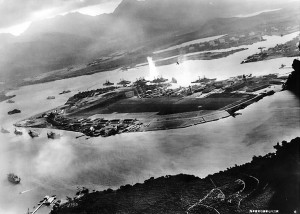 Located in the middle of Pearl Harbor is an island 335 acres in size. In Hawaii’s early days, it was known as Mokuumeume, meaning Island of Strife. It amazes me just how close that name is to the reality that is the island that is now known as Ford Island. I don’t think that strife is a constant companion of the island, but on this day, December 7, 1941…the date that will live in infamy, Ford Island was at center stage as one of the worst attacks in history took place on American soil. The participants, from the American side anyway, would have most certainly have chosen not to be there…if they had been given a choice. The island had changed hands several times, before finally ending up as a part of the military installation that was Pearl Harbor.
Located in the middle of Pearl Harbor is an island 335 acres in size. In Hawaii’s early days, it was known as Mokuumeume, meaning Island of Strife. It amazes me just how close that name is to the reality that is the island that is now known as Ford Island. I don’t think that strife is a constant companion of the island, but on this day, December 7, 1941…the date that will live in infamy, Ford Island was at center stage as one of the worst attacks in history took place on American soil. The participants, from the American side anyway, would have most certainly have chosen not to be there…if they had been given a choice. The island had changed hands several times, before finally ending up as a part of the military installation that was Pearl Harbor.
Every year, as Pearl Harbor Remembrance Day comes around, I try to write a story about that dreadful day, and this year, while looking at Pearl Harbor on Google Earth, my thoughts turned to that little island that was at the center of the attack. How must those men have felt? Everything happened so fast. There wasn’t even time to get the planes in the air. While the ships were being bombed around them, the pilots, mechanics, and airfield crew could only stand around watching…and dodging bullets. Of course, for most of them, that was impossible. The death toll that horrific day was 2403. In addition, there were 1178 people wounded. The emotional toll was beyond the imagination. This was the event that finally brought the United States into World War II.
I began to wonder what the people who were there were thinking as the events of the attack unfolded. There was no way to get off the island. If they had tried, they would surely have been killed. There were bombs going off on all sides of the island. Ships were sinking, airplanes were destroyed, and buildings were on fire or blown up. It was as if the world was coming to an end…or in reality, it was like waking up and finding yourself literally in Hell. My mind struggled to imagine how they must have felt…wishing and praying that all this was a dream and that they could be somewhere else…anywhere else. Still, they knew that it was real, and they were there, and 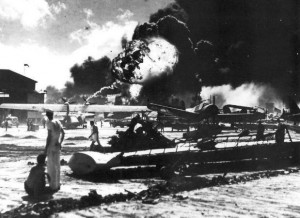
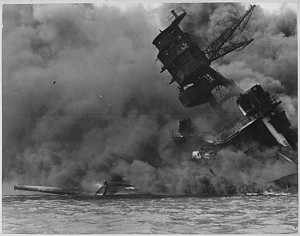 nothing would ever be the same again. They knew that the world as they had known it, had vanished…never to exist again. Of course, our country would come back from this attack, because we are a resilient people, but we would never be the same. We were less trusting of our enemies, something I see again in this day and age of terrorism, and something I think is important.
nothing would ever be the same again. They knew that the world as they had known it, had vanished…never to exist again. Of course, our country would come back from this attack, because we are a resilient people, but we would never be the same. We were less trusting of our enemies, something I see again in this day and age of terrorism, and something I think is important.
Being too trusting of our enemies in December of 1941, was exactly what paved the way for a surprise attack on December 7, 1941, and being too trusting today could do the same thing. It is imperative that we protect our people at all costs…even if it makes us seem heartless now. As in the case of the attack on Pearl Harbor, second chances at protecting our people don’t usually come. By the time we realize that we have made a mistake, it is too late, because it has become a fatal mistake. The men and women who survived the attack on Pearl Harbor knew first hand that our enemies hate us and want nothing less that death for America. That, I believe is the valuable lesson the people who survived that horrific attack took away that fateful day, and one we all need to seriously consider today.
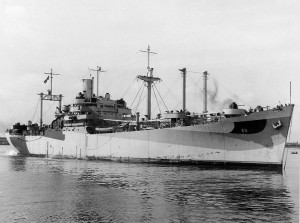 Any time ammunition, explosives, and bombs are being stored in a smaller space, and handled by multiple people, there is a possibility of disaster. The USS Mount Hood was the lead ship of her class of ammunition ships for the United States Navy in World War II. Her life was short lived. The North Carolina Shipbuilding Company began work on the ship on September 28, 1943, and the intended name of the ship was SS Marco Polo. It was first launched on November 28, 1943, and aquired by the Navy on January 28, 1944. It was commissioned the USS Mount Hood on July 1, 1944. The ship was named after Mount Hood, the volcano in the Cascade Range in Oregon.
Any time ammunition, explosives, and bombs are being stored in a smaller space, and handled by multiple people, there is a possibility of disaster. The USS Mount Hood was the lead ship of her class of ammunition ships for the United States Navy in World War II. Her life was short lived. The North Carolina Shipbuilding Company began work on the ship on September 28, 1943, and the intended name of the ship was SS Marco Polo. It was first launched on November 28, 1943, and aquired by the Navy on January 28, 1944. It was commissioned the USS Mount Hood on July 1, 1944. The ship was named after Mount Hood, the volcano in the Cascade Range in Oregon.
Following a short fitting out and shakedown period in the Chesapeake Bay area, the USS Mount Hood reported for duty to ComServFor, Atlantic Fleet on August 5, 1944. She was assigned to carry cargo to the Pacific, and she pulled in to Norfolk, where her holds were loaded. The she was transfered to the Panama Canal as part of 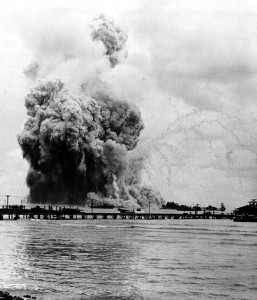 Task Group 29.6. She finally ended up Seeadler Harbor at Manus Island of the Admiralty Islands on September 22, 1944. There she was assigned to ComSoWesPac. The ship was to be dispensing ammunition and explosives to ships preparing for the Philippine offensive.
Task Group 29.6. She finally ended up Seeadler Harbor at Manus Island of the Admiralty Islands on September 22, 1944. There she was assigned to ComSoWesPac. The ship was to be dispensing ammunition and explosives to ships preparing for the Philippine offensive.
At 8:30am, on November 10, 1944, 17 of USS Mount Hood’s crew members, including Lieutenant Lester H Wallace left the ship to go ashore. At 8:55am, while walking on the beach the men saw a flash and heard two quick explosions. They immediately jumped back in their boat and headed for their ship, only to find that, like volcanoes tend to do, the USS Mount Hood had exploded. There was literally no ship to come back to, and other ships in the area were heavily damaged too. The USS Mount Hood had been anchored in 35 feet of water, and had exploded with an estimated 3,800 tons of ordnance material on board. Mushrooming smoke rose to 7,000 feet, completely obscuring the ship and the surrounding area for approximately 500 yards. It was easy to see where USS Mount Hood had been, because the explosion created a trench in the ocean floor 1,000 feet long, 200 feet wide, and 40 feet deep.The largest remaining piece of the hull was found in the trench and measured about 16 feet by 10 feet. No other remains were found except the fragments which struck the other ships in the area. No human remains were recovered of the 350 men aboard USS Mount Hood or the small boats loading alongside at the time of the explosion.
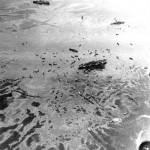
There were 271 men in surrounding ships that were injured, and 82 of nearby Mindanao’s crew were killed. In all, 22 small boats and landing craft were sunk, destroyed, or damaged beyond repair. The exact cause of USS Mount Hood’s explosion was never determined, but since the possibility of enemy action was remote, it was thought that rough handling of some of the explosives during the loading and unloading process was to blame for the disaster. With no survivors and so little of the ship left, I’m sure that the investigation was an impossible task. I do find it ironic that a ship named after a volcano, ended up exploding, and I find the loss of life to be a very sad thing indeed.
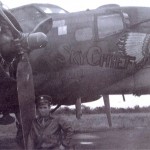 Many times I have written about my Dad’s time in the war, and what he went through, but I’m not sure I truly understood what he went through. Dad never talked about the war much, and maybe that led us to believe that what he went through wasn’t so bad for him. In reality, I don’t think I knew much about Dad’s service time at all. My nephew loaned me a movie called Fortress, and I was very interested in watching it. I don’t know what I expected it to be, but it was not. Everything on the B-17 happened so very fast.
Many times I have written about my Dad’s time in the war, and what he went through, but I’m not sure I truly understood what he went through. Dad never talked about the war much, and maybe that led us to believe that what he went through wasn’t so bad for him. In reality, I don’t think I knew much about Dad’s service time at all. My nephew loaned me a movie called Fortress, and I was very interested in watching it. I don’t know what I expected it to be, but it was not. Everything on the B-17 happened so very fast.
While the movie was quite graphic, and not one that some people would like to watch, it was based on a true story and it gave me a very different perspective about what it was like to fly in a B-17 Bomber. I knew that the life of a ball turret gunner in combat was a mere twenty minutes, and I knew that during the time Dad was on the B-17, there was at least one ball turret gunner who was killed. They tried to save him, but it was not to be. In an instant it was over.
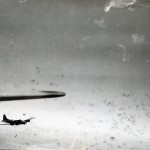
The Flying Fortress, as the B-17 Bomber was called, was one of the safer parts of the war, but that meant nothing when you are flying to a bomb drop and the enemy doesn’t want you to make it. The movie brought home just how hard it was to really spot the enemy planes. They would say that the enemy was right there, and I found myself thinking, “Where?” Then suddenly there they were, and the men on the plane had been firing for several seconds already. It felt like trying to explain how to spot the enemy, and by the time you get the word “well” out, you have already been hit.
While any gunner position was dangerous, I was struck by how exposed the waist gunners were. In case you don’t know, the waist gunners are the guys that shoot out the side doors of the plane. The doors are open, leaving them with very little protection. They had to be on their toes, because the enemy was shooting for their gun, and if they weren’t paying attention, they were shot before they got a second chance to pay attention. That made things really hard, because they also felt a close commraderie with their partner, the other waist 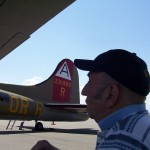 gunner, and if their partner got shot, it was hard to stay on task…but that was hard for any one of the men on the plane.
gunner, and if their partner got shot, it was hard to stay on task…but that was hard for any one of the men on the plane.
Watching the men they worked with every day, get shot and killed became a normal thing. Being normal and being able to cope, are two very different things. These men had to hold it together, while quietly falling apart inside. They knew their friend was dead, and yet they had to do their job. They couldn’t grieve. They couldn’t stop. They had to push that picture of their dead friend way back inside themselves, and do their job. Lives depended on it…including their own. I knew that my dad was on a B-17, but until I watched that movie, I really didn’t understand all of what that meant.
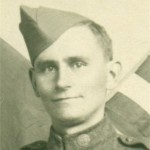 When we think of war, we usually think of planes and tanks, bombs and guns, but lately I have been wondering just what the life of a foot soldier was like. My grandfather served in World War I, and after reading a little bit about what it was like for the men in the trenches, I find myself feeling very thankful that my grandfather was a cook. I don’t know how he got that position, considering that so many soldiers were needed, and the number needed grew daily, or even hourly, I just don’t know how he was so blessed to be a cook. Grandpa Byer was always such a gentle, soft hearted man, so I have a really hard time imagining him in a position of having to kill someone. I read that when new foot soldiers came to the front, many lost their lives on the first day, because they got into the trenches, and got an overwhelming urge to peek out over the top to see if the enemy was coming. The instant they peeked over the top, a sniper’s bullet would rip through their head, killing them instantly. The commanding officers began telling the new men to keep their head down…no matter what.
When we think of war, we usually think of planes and tanks, bombs and guns, but lately I have been wondering just what the life of a foot soldier was like. My grandfather served in World War I, and after reading a little bit about what it was like for the men in the trenches, I find myself feeling very thankful that my grandfather was a cook. I don’t know how he got that position, considering that so many soldiers were needed, and the number needed grew daily, or even hourly, I just don’t know how he was so blessed to be a cook. Grandpa Byer was always such a gentle, soft hearted man, so I have a really hard time imagining him in a position of having to kill someone. I read that when new foot soldiers came to the front, many lost their lives on the first day, because they got into the trenches, and got an overwhelming urge to peek out over the top to see if the enemy was coming. The instant they peeked over the top, a sniper’s bullet would rip through their head, killing them instantly. The commanding officers began telling the new men to keep their head down…no matter what.
World War I was supposed to be a war that ended quickly, but that isn’t how it happened. Going in, it was expected that the whole thing would end after one big movement…shock and awe, I suppose, but the other side had a different idea, and the soldiers were forced to hunker down for the long haul. In the end, the war lasted from the fall of 1914 to the spring of 1918. There was movement in the beginning as the Germans marched through Belgium and France on their way to Paris, but then while the lines did advance and retreat, there was not a lot of movement until the war neared it’s end.
I can’t say that I have much insight into the ways of war, other than what I have been told or have read, but it doesn’t take much imagination to be able to picture those fear filled kids hearing the gun shots all around them, just hoping they can keep their wits about them long enough not to do something stupid that could cost them their lives. I don’t think war has changed so much in recent years either. My brother-in-law, Ron Schulenberg told me a little bit about his war experience during Operation Desert Storm. Ron was a foot soldier, and he told me about marching across the desert, stepping over the bodies of the enemy’s dead soldiers, and getting to the point where something like that no longer made him feel like he was going to be sick. For me, it is hard to imagine how much death you would have to see to put you in a place of being able to just step over a dead body and march on.
Almost every war has it boots on the ground part. They are often the first soldiers in the war, and they have to 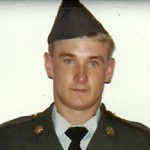 pave the way for those who will follow. They are a tough, almost street smart…or is it trench smart…soldier, who knows what to expect from guerilla warfare, or at least as much as anyone can know what to expect before they go to war. It occurs to me that a soldier going into a war is a completely different person than a soldier coming out of a tour of duty. You simply can’t spend time around all that death, not knowing if you will ever leave that place, and not be completely changed by it. No wonder so many of our soldiers come out of their tour of duty with Post Traumatic Stress Disorder. These men came into the war as kids, and came out feeling like old men. That is not the way they imagined their post high school years, but when you are serving your country, your high school/boyhood ideas have to be set aside to make way for the skills and mindset you must have to survive the life of a foot soldier.
pave the way for those who will follow. They are a tough, almost street smart…or is it trench smart…soldier, who knows what to expect from guerilla warfare, or at least as much as anyone can know what to expect before they go to war. It occurs to me that a soldier going into a war is a completely different person than a soldier coming out of a tour of duty. You simply can’t spend time around all that death, not knowing if you will ever leave that place, and not be completely changed by it. No wonder so many of our soldiers come out of their tour of duty with Post Traumatic Stress Disorder. These men came into the war as kids, and came out feeling like old men. That is not the way they imagined their post high school years, but when you are serving your country, your high school/boyhood ideas have to be set aside to make way for the skills and mindset you must have to survive the life of a foot soldier.

